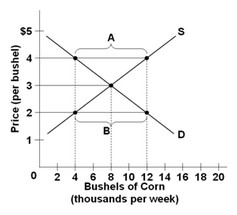Suppose an economy produces only three products, A, B, and C. Quantity purchased and changes in the prices of these items over a period are shown below:??Average Price Per UnitProductQuantityYear 1Year 2A10$10$8B152022C85055Using year 1 as a base, the value of the country's nominal GDP in year 2 is:
A. the same as nominal GDP in year 1.
B. $850, assuming no change in quantity from year 1 to year 2.
C. $800 assuming no change in quantity from year 1 to year 2.
D. $3,270 assuming no change in quantity from year 1 to year 2.
Answer: B
You might also like to view...
Use the following diagram for the corn market to answer the question below.  If the price in this market is fixed at $2 per bushel, then
If the price in this market is fixed at $2 per bushel, then
A. buyers will find too much corn in the market. B. buyers will be able to get as much corn as they wish to buy. C. sellers will not be able to sell all the corn that they intended to sell. D. sellers will quickly run out of corn that they bring to market.
At any price the monopolist sets, it will sell:
A. as many as it wants. B. as many as demanders are willing to buy. C. more than a perfectly competitive market would sell. D. less than quantity demanded to keep the item rare.
What are the two largest sources of revenue for the average US state govt?
a. sales taxes and excise taxes b. corporate income taxes and property taxes c. property taxes and US import tariff revenues (taxes on imported goods) d. income taxes and sales taxes
If an upstream monopoly and a downstream monopoly vertically integrate into a profit-maximizing monopoly, then the total amount of deadweight loss in the industry
A) will increase. B) will decrease. C) will remain unchanged. D) cannot be determined.